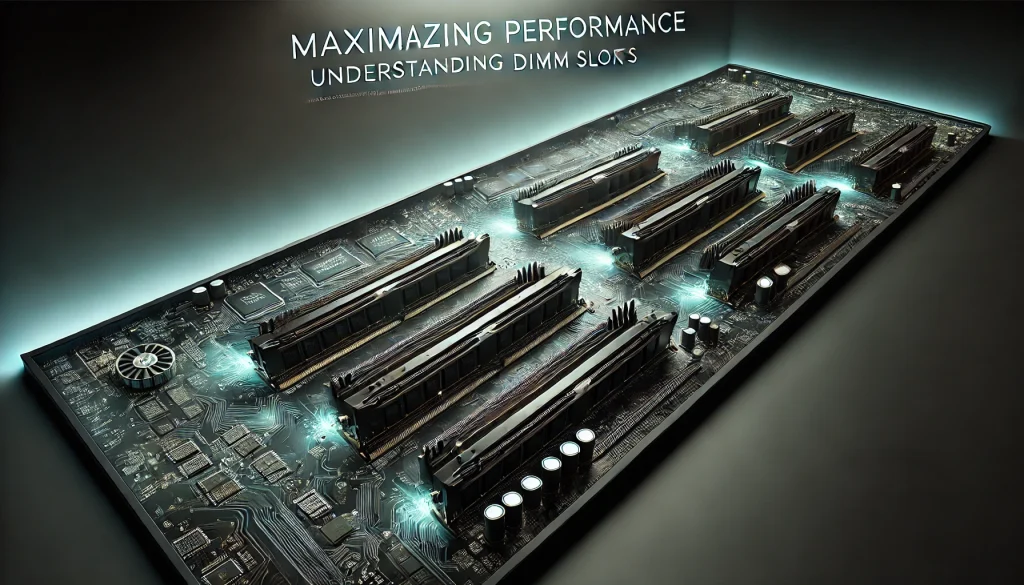
Understanding DIMM Slots: A Complete Guide Dynamic Inline Memory Modules (DIMMs) are essential parts of contemporary computer systems because they act as the main system memory interface. Anyone wishing to construct, modify, or troubleshoot a computer must have a solid understanding of DIMM slots. These slots are crucial in determining the compatibility & performance of the memory that is installed in a system; they are more than just physical connectors. Every motherboard has a set number of DIMM slots, which can have a big impact on the computer’s overall performance.
For example, a motherboard with four DIMM slots can accommodate more memory than one with just two, allowing users to manage larger datasets or run more applications at once. Also, memory performance may be impacted by DIMM slot configuration. The ability to use dual-channel or quad-channel memory configurations on many motherboards can improve system responsiveness and data transfer rates.
Users can choose memory modules more wisely if they are aware of the specifications and how these slots operate. For professionals who depend on high-performance computing, such as gamers and content producers, this information is especially crucial. Users can maximize the performance and longevity of their systems by understanding the nuances of DIMM slots.
Different generations of memory technology are supported by different types of DIMM slots. DDR (Double Data Rate), DDR2, DDR3, DDR4, and the most recent DDR5 are the most popular varieties. Enhancements in speed, bandwidth, and power efficiency are available with every generation. DDR4 DIMMs, for instance, usually run between 2133 MHz and 3200 MHz, but DDR5 DIMMs can run faster than 4800 MHz.
Older DIMM types are incompatible with modern motherboards due to technological advancements, so it is essential for users to match their memory modules with the right slot type. Apart from the variations in generation, DIMM slots also differ in terms of pin count & physical design. For DDR3, standard DIMMs have 240 pins; for DDR4 & DDR5, they have 288 pins. Additional specialized versions, such as SO-DIMM (Small Outline DIMM), are utilized in laptops and small systems because of their smaller size.
Maintaining compatibility when replacing or upgrading memory modules requires an understanding of these differences. Also, users need to be aware of the particular specifications of their motherboards, as some may only support specific DIMM types or have installable memory limits. A little attention to detail will enable you to complete the simple task of identifying DIMM slots on a motherboard. DIMM slots are long, rectangular connectors that are usually found close to the CPU socket.
They can be color-coded to show which slots should be filled first for best results. The DIMM slots on most motherboards are grouped in sets or pairs and are frequently designated A1, A2, B1, and B2. Because it specifies how memory modules should be installed to maximize performance, this labeling is essential for configuring memory in dual-channel or quad-channel modes. The motherboard’s manual, which includes schematics and specifications for every part, can be used by users to find these slots.
Also, arrows or labels next to each slot are examples of visual indicators that many manufacturers place on the motherboard itself. The documentation for the motherboard is a great place to start if a user is unclear about the setup or compatibility of their memory modules. As a result, users can make efficient use of their DIMM slots without worrying about performance problems or component damage. For users wishing to increase the capabilities of their system, optimizing performance through dual-channel & quad-channel memory configurations is crucial.
When two memory modules can function concurrently, dual-channel memory essentially doubles the data transfer rate when compared to single-channel configurations. This configuration can result in notable enhancements for activities requiring a lot of bandwidth, like video editing or gaming. Users must place their RAM modules in the appropriate slots as specified by the motherboard’s manual in order to benefit from dual-channel memory. By enabling four modules to operate concurrently, quad-channel memory expands on this idea. High-end motherboards intended for workstations or gaming rigs that require optimal performance usually have this configuration. To achieve optimal performance, however, module specifications must be carefully considered; all installed RAM should ideally match in terms of timings, size, and speed.
Users should also think about how much RAM is required overall for their particular applications; while more RAM can enhance multitasking, it’s crucial to strike a balance between speed & capacity to prevent performance snags. DIMM module installation is a reasonably easy procedure that requires few tools and safety measures. Make sure the computer is turned off and disconnected from all electrical sources before starting the installation.
Also, users should ground themselves to avoid damaging sensitive components with static electricity. Following these safety measures, users can find the DIMM slots on the motherboard by opening their computer casing. Prior to installing a DIMM module, users must line up the module’s notch with the matching key in the slot. By guaranteeing that the module can only be inserted in one direction, this alignment helps to avoid unintentional damage from improper installation.
Once the module has been properly positioned, users should apply pressure until they hear a click, signifying that the module is firmly seated. To enable dual-channel or quad-channel configurations, it is recommended that RAM modules be installed in pairs or sets in accordance with the motherboard’s specifications. After installing all the modules, users can shut down their computer and turn it on to make sure the BIOS has detected the new memory. Despite their simple design, DIMM slots can cause a number of problems for users when they install or use them.
One frequent issue is that after installing new RAM, the system does not boot up. Modules that are not seated correctly or memory types that are incompatible may be the cause of this problem. In order to troubleshoot this issue, users should first make sure that every module is installed correctly & securely in its designated slot. If problems continue, it might be essential to take out all of the RAM and test each module separately in various slots to find any malfunctioning parts. After upgrading RAM, system instability or crashes are another common problem.
Mismatched memory specifications or improper BIOS settings are frequently the cause of this instability. The BIOS settings should be checked by users to make sure that the memory timings and voltages are set correctly in accordance with the manufacturer’s instructions. Any underlying problems with RAM integrity or module compatibility can also be found by using memory diagnostic tools. By methodically resolving these typical problems, users can guarantee the seamless and effective operation of their systems. For improved performance, enthusiasts frequently overclock their systems to exceed the recommended specifications. Overclocking entails raising the operating frequency of RAM above its rated speed while preserving system stability when it comes to DIMM slots and memory modules.
For taxing applications like gaming or content production, this procedure can result in noticeable performance gains. The stability of the power supply, motherboard capabilities, and cooling options must all be carefully taken into account when overclocking. In order to effectively overclock RAM through DIMM slots, users usually go to their BIOS settings and change variables like voltage levels, timings, & frequency. This procedure must be carried out carefully; after making each modification, system stability should be tested using stress-testing software in tiny increments. Also, since overclocking produces extra heat that, if not controlled, could potentially harm components, suitable cooling solutions must be used.
Through comprehension of the relationship between DIMM slots and overclocked memory modules, users can maximize performance while lowering the risks involved in this cutting-edge technique. A system’s performance and general functionality can be greatly improved by upgrading it with more DIMM slots. While many motherboards nowadays have multiple DIMM slots for simple expansion, some older models might not have enough slots for future upgrades or might have limits on the amount of RAM they can support. It’s crucial to first review the motherboard specs when thinking about an upgrade to find out what kinds of RAM are compatible and how many extra slots are available.
Users should also think about things like channel configuration and total capacity when upgrading RAM with more DIMM slots. For example, a user who wants to add two more 8GB modules to increase their 32GB total capacity from two 8GB modules already installed in dual-channel mode must make sure that all four modules are compatible in terms of timing and speed for best results. Also, if the motherboard supports dual-channel or quad-channel configurations, making use of all available slots can help maximize bandwidth.
Through meticulous planning of DIMM slot upgrades, users can guarantee compatibility and stability while greatly increasing the capabilities of their systems. In conclusion, anyone building or upgrading computers needs to understand DIMM slots. Understanding these parts enables users to make well-informed decisions that greatly improve their computing experience, from identifying and recognizing the various types of DIMM slots on motherboards to optimizing performance through appropriate configurations and resolving common problems.
Knowing the nuances of DIMM slots will surely help you reach your performance objectives, whether you’re a hobbyist trying to overclock your system or a casual user hoping for an upgrade.
